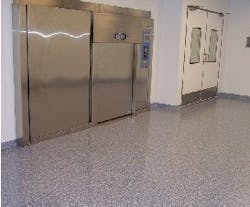Hardly an hour goes by that the media doesnt remind us about impending flu pandemic, HIV risks and the threat of biological terrorism. As a response, private industry and the U.S. government have invested billions of dollars here and abroad into the research, development, and manufacture of new and improved vaccines.
A critical consideration to the buildings design and construction was the flooring system selected. As a major building component, the flooring system and its ability to perform under harsh conditions have a critical impact on day-to-day operations in the manufacture of pharmaceuticals or, in this case, vaccines.
Rigorous Requirements
Building material selection for pharmaceutical manufacturing has many unique requirements that set it apart from other industries. In the case of the Vaccine Pilot Plant, exhaustive measures were taken to assure that federal Current Good Manufacturing Practices (CGMP) regulations were strictly followed.
The all-encompassing regulations include the material selection and construction of the facility and, once completed, all of the procedures and activities performed there. For example, mechanical structures such as highly sophisticated HVAC and water purification systems and construction materials for walls and ceilings come under close scrutiny, as do the flooring systems.
While in many industries the function of floor coatings is primarily to protect the concrete floor slab from cracking, chemical attack and mechanical wear. Especially critical for pharmaceutical, medical and research facilities are the issues of sanitation and safety. Floor coatings selected for these facilities must be durable enough and thick enough to create a protective barrier that prevents contaminants from permeating the concrete substrate and ensures a hygienic surface. Thickness is necessary to provide additional protection from the rigors of steam cleaning.
Hygienic Floors
Like many other pharmaceutical sites, the Vaccine Pilot Plant has a concrete floor. Since the very nature of concrete is porous, specialty floor coatings are needed to protect it with hygienic, seamless, wall-to-wall coverage. But coating concrete has its challenges. For example, the inherent moisture content of concrete makes it impossible to apply many protective floor coverings before the concrete is cured usually about 28 days. Not waiting the specified time results in coating failures such as blistering, caused by moisture vapor emissions.
But newer technology in coatings has made it possible to apply protective coatings over damp concrete that provide long-lasting durability. These coatings are water-based urethane modified cementitious slurry mortar systems.
The coating selected for plant manufacturing areas and corridors at the Vaccine Pilot Plant was Bio-Flake Decorative Flooring System, a decorative version of a water-based urethane flooring system from Sherwin-Williams called FasTop System. The decorative system is available in various color combinations and was specifically designed to provide functional yet aesthetic flooring for pharmaceutical, research and biotech applications.
Attractive looks aside, the primary reason for selecting a coating system for pharmaceutical plants is performance. The ideal coating will cure quickly, allowing a fast return to service, and will have low odor and low Volatile Organic Compounds (VOCs). In addition, the technology selected is inherently more thermal shock resistant than epoxy and vinyl ester systems of similar thicknesses due to a coefficient of thermal expansion similar to that of the concrete substrate.
Pharmaceutical plant floor coatings also must resist most acids, oils, solvents and cleaning solutions. Floors in the manufacturing sections need to stand up to frequent cleaning which may take place daily, depending on vaccine production schedules. Of critical importance is the coatings impact and abrasion resistance, since floors at the plant are exposed to high traffic from heavy machinery and tools.
For example, at the Vaccine Pilot Plant, large (200 500 liter) tanks of liquid solution with mounted wheels are frequently moved within the production area. Chromatography and filtration equipment, which are used as part of the vaccine purification process, are also transferred from different locations during the day.
Providing a safe and resistant finish is another important feature for floor coverings in pharmaceutical settings. Urethane systems such as the one selected for the Vaccine Pilot Plant are engineered to offer slip resistance. Various textures and colors may be achieved by broadcasting aggregates into these slurries to create slip resistant floors. The degree of texture is typically determined by the conditions of the operation, the frequency of cleaning and maintenance, and presence of potentially slippery substances.
Applying Floor Coatings
As with any coating application, following the required steps prescribed by the manufacturer is a must. These include selecting experienced, certified contractors for coating system application, properly preparing the surface for coating, and ensuring that guidelines are followed for recommended ambient conditions, surface and material temperatures during application and curing.
At the Vaccine Pilot Plant, the surface was abrasive-blasted to remove all surface contaminants and imperfections and to achieve a concrete surface profile equal to 40-60 grit sandpaper. Protrusions were ground smooth and cracks filled with a compatible filler. The floor coating system was applied in four different steps beginning with the slurry coat, typically spread over the surface with a pin or screed rake or flat trowel. A bonding coat was then applied with a roller followed by the broadcast of the paint chip blend into this material. The last step was the spray application of the seal coat.
Development of the Vaccine Pilot Plant was completed in October 2005. While finishing touches and building adjustments are being made, staff is being hired: the plant currently has 35 biotech personnel. Eventually, the facility will employ about 100.






